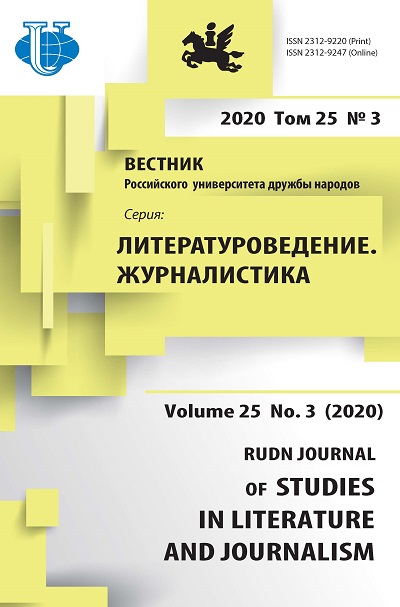The image of Judas in the new and the newest fiction
- Authors: Romenskikh P.V.1, Meskin V.A.1
-
Affiliations:
- Peoples’ Friendship University of Russia (RUDN University)
- Issue: Vol 25, No 3 (2020)
- Pages: 424-433
- Section: LITERARY CRITICISM
- URL: https://journals.rudn.ru/literary-criticism/article/view/24819
- DOI: https://doi.org/10.22363/2312-9220-2020-25-3-424-433
- ID: 24819
Cite item
Full Text
Abstract
The purpose of the article is to answer the question: why did the uncompromising condemnation of the traitor disciple become a thing of the past, and why did writers begin to understand and then justify the actions of Judas in their own manner in the second half of the 19th century? To solve the problems, caused by this goal, the authors refer to the ideas of philosophers of the new time, who significantly influenced the worldview of artists of the word, especially G. Hegel, A. Schopenhauer, S. Kierkegaard, and in more detail - F. Nietzsche. Special attention was paid to the writers, who lived at the end of the new time and at the beginning of the modern time and who created the most striking works on this biblical theme. The philosophy and poetics of the Swede - T. Gedberg and the Russian - L. Andreev are analyzed in detail. This is the first such a detailed appeal to the famous Swede in a detailed comparison of his story about Judas with Andreev’s story about this character from the New Testament in Russian literary studies. It is proved that both writers reacted to the “crisis of consciousness” that was revealed at that time and that Nietzsche had the strongest attention on both prose writers, while in Andreev’s case Judas appears as a type of the superman.
About the authors
Polina V. Romenskikh
Peoples’ Friendship University of Russia (RUDN University)
Author for correspondence.
Email: Arta-22@yandex.ru
fourth-year student of the Department of Russian and Foreign Literature of the Faculty of Philology
10 Miklukho-Maklaya St, bldg 2, Moscow, 117198, Russian FederationVladimir A. Meskin
Peoples’ Friendship University of Russia (RUDN University)
Email: vameskin@yandex.ru
Doctor of Philology, Professor of the Department of Russian and Foreign Literature of the Faculty of Philology
10 Miklukho-Maklaya St, bldg 2, Moscow, 117198, Russian FederationReferences
- Oz, A. (2017). Iuda [Judas]: novel (V. Radutskiy, Trans.). Moscow, Fantom Press.
- Htibscher, A. (1994). Mysliteli nashego vremeni (62 portreta) [The Thinkers of Our Time (62 Portraits)] (I. Sats, Trans.). Moscow.
- Kierkegaard, S. (1993). Strakh i trepet [The Fear and the Awe] (N. Isaeva, S. Isaev, Trans.). Moscow.
- Nietzsche, F. (1998). Collected works (vol. 2). Saint Petersburg.
- Hedberg, T. (2002). Judas. Stockholm, Atlantis Publ.
- Fatov, N.N. (1924). Molodye gody Leonida Andreeva [The young years of Leonid Andreev]. Moscow, Zemlya i fabrika Publ.
- Maxim Gorky. (1922). Kniga o Leonide Andreeve [The Book about Leonid Andreev]. Berlin, Moscow.
- Chukovskii, K.I. (1960). Lyudi i knigi [The People and the Books] Moscow.
- Shubin, E.A. (1972). Khudozhestvennaya proza v gody reaktsii. Sud'by russkogo realizma nachala XX veka [Fiction during the Years of Reaction. The Fates of Russian Realism at the Beginning of the 20th Century]. Saint Petersburg.
- Tolkovaya Bibliya [The Explanatory Bible] (vol. 8). (1911). Saint Petersburg.
- Tatarinov, A.V. (2001). Leonid Andreev. Russkaya literatura rubezha vekov (1890-e – nachalo 1920-kh godov) [The Russian Literature of the Turn of the Century (1890s – early 1920s)] (vol. 2). Moscow, IMLI RAN Publ., Nasledie Publ.
- Zerkalov, A. (Mirer, A.). (2012). Evangelie Mikhaila Bulgakova [The Mikhail Bulgakov’s Gospel]. Moscow.
- Apostol Iuda Iskariot Leonida Andreeva i evangel'skaya besplodnaya smokovnitsa [The Leonid Andreev’s Apostle Judas Iscariot and the Gospel Barren Fig Tree]. (2010). In L.A. Iezuitova, Leonid Andreev i literatura Serebryanogo veka [Leonid Andreev and literature of the Silver age]: Choosen works. Saint Petersburg, Petropolis Publ.
- Voloshin, M.A. (1999). Iz neizdannogo [From Unreleased] (A.V. Lavrov, Preface, Publication and Notes]. Saint Petersburg, Aleteiya Publ.
- Merezhkovskii, D.S. (1996). Iisus neizvestnyi [Jesus the Unknown]. Moscow, Respublika Publ.
Supplementary files















